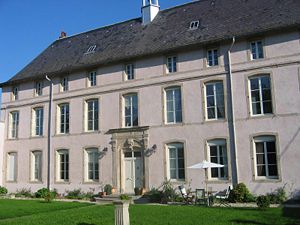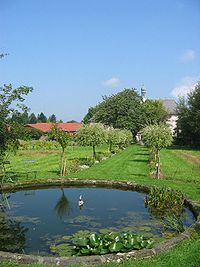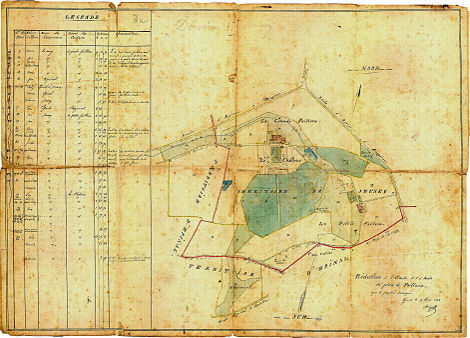- Château de Failloux
-
The Château de Failloux (Castle of Failloux) was built in the 18th century. It is located in the commune of Jeuxey in the Vosges département, northeastern France, a few kilometers from the historical center of Épinal, and takes its name from its hamlet, Grande Failloux. Etymologically, the term Failloux derives from the unusual abundance of deciduous trees in an area where generally dominated by coniferous trees. Although falling within the administrative area of the commune of Jeuxey, the site of Failloux is isolated from the village and is located closer to the town of Épinal. The castle entrance has an ornamental wrought-iron gate designed in the by the workshops of Jean Lamour, who built the gates of the Place Stanislas in Nancy, in France.
Contents
Introduction
The site of Faillouox is steeped in five centuries of history and the first recorded mention of the site can be traced back to the year 1445. Although historians have been unable to establish an exact date for the construction of the castle, extant documents including a letter from the Duke of Lorraine, Francis III, dated July 3, 1736 setting it up fief of Failloux, confirm that a manor house was among the properties of François-Léopold Masson, who thus became the first lord of Failloux.
Architecture
The features of manor house are similar to those common to many 18th century stately homes and comprises two dovecotes, a bell-tower, outbuildings, and a park.
The castle
The castle is a narrow building, 24 metres (79 ft) long, and only 6.5 metres (21 ft) wide with a height of about 8.5 metres (28 ft), providing three floors and an attic. Three low vaulted cellars provide the support for the building. At the time of its construction, the house had 21 rooms, one of which was used for indoor tennis. Some time around 1772, the rear part of the castle was widened, and fireplaces (à la royale” (with a large mirror above) added to two reception rooms. In one of the fireplaces, an iron plate on the bottom of the hearth is decorated with a capped blazon of a royal crown and flowers with lily. The main staircase is made of 21 relatively low, wide steps of single blocks. The wrought-iron banister was made by the same workshop that supplied the entrance gates.
Courtyard
This is one of the two dovecotes that flank the main entrance.One has a baker's oven and a smokehouse for pork.
The courtyard is a 24 metres (79 ft) × 24 metres (79 ft) square with two-story houses with slate four-sided hip roofs in the angles. The right-hand house still has a pigeon loft, and the ground floor has a well-preserved fireplace. Between these two houses, a wall supports a succession of surmounted cylindrical bars with spaded points. Two stone pillars, finished by a ballot box, support the grids of the entry. A stone alley leads to the castle. On its line is a fountain with water that comes out a head of a watery god. The whole is overcome by a large urn.
The roof
The roof with croups with four sides is covered with slates, and is dominated by a steeple of a bell gone back to 1625, and engraved “Jesus Maria”. At the top of this steeple, we distinguishe a crescent. It is probable that this symbol is imported from Othoman culture very popular in the 18th century.
The gates
The gate was created by the famous ironworker Jean Lamour who also made those that surround Place Stanislas in Nancy. The initials of the first owner appear in the high part of the gate (François-Léopold Masson), and those of the Collinet de la Salle family appear in the low part. It is now enough to examine this gate to imagine the destination of the castle. On each side of the central parts, we can see a succession of rubbles, violins, harps, fifres, bagpipes, horns and horns of hunting. The first instruments return to the pleasures of the music, or even the dance, the last seem invited to discipline hunting. By their decoration, the piles that support the gate give a movement of solemn base to the unit. During World War I in 1914, this gate would have been dismounted and hidden in sure place for fear of the German enemy steals it.
The park
Located opposite the castle, in top of a staircase, the park extends on a surface from one hectare, it was used like pleasure garden. In its center, a stone basin formed the starting point of four alleys (north, south, are, western). A real formal gardengarden. Today, there is a vegetable garden, a few vines, as well as a sheepfold and some animals.
The orangery
Built on the left of the castle, the orangery was preceded by a small garden with in its center a water basin and a spray. It contained until 1919, extremely rare exotic species of any beauty. After this date, the owner of the time, a retired officer, back from the colonies, made it convert into a transitory factory of buttons of mother-of-pearl, used to equip the soldiers of the many barracks of the area. Was it built at the same time as the castle? One can think it without being able to affirm it.
Failloux through the ages
As mentioned previously, it is almost impossible to give the exact date of the beginning and the end of the building work of the castle. We know however that it already exists in 1736. Another thing is sure. The farm located on the left of the castle is older. Two families of owners truly marked the history of the castle of Failloux: the Masson family and the Collinet de la Salle family.
Reminder of the historical context
Until 1766, Épinal and its area French but is not attached to Duchy of Lorraine. In 1670, the French take the city of Nancy, the duke Charles IV takes refuge in Épinal. The city defended by the Count de Tornielle is attacked by the troops of the marshal of Créqui. This last seizes the town of Épinal on September 19 and its castle on September 28. The city is condemned to pay an exorbitant sum with the frank French of thirty thousand barrois and must demolish with its expenses the castle and the fortifications. These conditions required on order of the king were intended to frighten Lorraine. The castle is destroyed but the fortifications are destroyed only partially. The amount of the amount of money to be poured is strongly decreased after the rendering of the other Lorraine fortified towns. But the fall of the city represents a turning, the city ceases being a fortified town. The city is francized gradually. In 1736, the duke Francis III, wire of Léopold, wife the archduchess Maria Theresa of Austria, heiress of Habsbourg. Alsace was gradually annexed to the kingdom of France during the reign of Louis XIV. Because of that, Lorraine and Barrois are nearly a foreign enclave in its territory. Louis XV refused to see it pass to the hands of a great foreign power: the Empire, its hereditary enemy. By an agreement between Austria and France, François gave up Lorraine to become Grand Duke of Tuscany (an Austrian possession), and France accepted Pragmatic Sanction of the emperor. To spare feelings, the duchies were not immediately annexed in France but given for life to the father-in-law of Louis XV, the former king of Poland, Stanisław Leszczyński who, since 1737, was the last sovereign duke. The country had been controlled in fact by a French-named chancellor. On the death of Stanislas in 1766, Lorraine and Barrois were reorganized and annexed to France.
The construction of the castle
François-Léopold Masson, lawyer, adviser and prosecutor of the king in Épinal, enjoyed rights and preferences of exception. In 1736, it was ennobled and made build the castle. He thus becomes the first owner and becomes the first lord of Failloux. On August 13, 1761, François-Léopold Masson, lord of Failloux, accommodates Ladies of France, Adelaïde and Victoire, girls of Louis XV, at the time of their passage to Épinal, on the road of very in vogue terms of Plombières-les-Bains.
The Collinet de la Salle family
Two years after the death of F.L. Masson, on July 21, 1767, for problems of succession and because of the too great number of heirs, the field is put on sale. In 1768, François Loyal, receiver of the sums of money of the town of Épinal, and his wife, buy the fief of Failloux, which they resell four years later. On April 7, 1772, Charles-François-Xavier Collinet de la Salle, rider, lord of Fremifontaine and Bouzillon and his wife Anne-Marie Magdelaine Maurice de Sarisming buy each one half of the stronghold of Failloux. He then becomes Seigneur of Frémifontaine and Failloux. During the Revolution, the Collinet family of the Room will suffer. It will have been necessary to justify nonemigration of his wife (left in cure to Switzerland) and of her son so that the fief remains between the hands of Charles-François-Xavier. One of his cousins, Pierre-Maurice Collinet de la Salle, will not have as much chance, and will be translated in front of Revolutionary Tribunal, will be condemned and executed in Paris, the same day as Charlotte Corday. With the death of Charles-François-Xavier Collinet de la Salle, which occurred in its castle on November 21, 1813, his three children inherit the Failloux and others. Following family arrangements, only their son Charles-Marie will remain about it the single owner until his death. When on June 1, 1863, he dies, unmarried, at the 89 years age, it is the end of the fief of Failloux. It from now on will be parcelled out in three parts: the castle, the farm of Grande Failloux, and that of Petite Failloux.
The Franco-Prussian War in Failloux
The castle of Failloux occupies a “strategic” site with the accesses of the Epinal-native agglomeration. It makes it possible, indeed, to supervise the roads, which, coming from Rambervillers, give access, by Poissompré, the suburbs of the Michaelmas and Ambrail, in the centers of the city. In 1870, after the defeats at the borders and with Sedan, 250 national guards go up of Épinal for “to defend the castle of Failloux” . It is there, which on October 12, 1870, held the ultimate combat that delivered to the Prussian armies, the defenders of Épinal. It arises from the testimonys transcribed in “the army of the East” that:
“the battalion of the national guard of Épinal, was composed of 7 companies of a total staff complement of approximately 1500 men. […] The 6th company, without chiefs, sprang beyond the line of defence, and was thrown in the property of Failloux dominated on all sides by the enemy who was in wood neighbors. These some national guards are transferred soon attacked by a German cloud. […] These Epinal-native troops did not cease facing the enemy whom they defied at very short distance (often with 100 meters), all disseminated behind the wood clusters, in the farm of Failloux. A long time, they were defended, but finally had to move back in front of the number and were partly disarmed and captive. There, especially, the national guard had to regret of the victims, six men died and eight wounded and 12 other prisoners. ” The combat lasted four hours, leaving the prefect time to transfer his administration, the material of railroad, the case of general treasury of a value of 4 million, and 400 wounded military hospital. Following this war, the castle remained French, as well as the department of the Vosges, which will never form part of Alsace-Lorraine.Failloux in the XXth century
With the death of Charles-François-Xavier Collinet de la Salle in 1863, the field of Failloux is nothing any more but one simple place of dwelling and farm. The owners will follow one another in a number until in the years 1960. One of them will make cut down an alley of oaks centenaries connecting the castle to the way of Failloux, located on the other side of the current expressway (RN 57). It will also benefit from it to withdraw the exotic plants located in the orangery to make a factory of mother-of-pearl buttons of it. Surprisingly, one knows less the use of the castle at the XXème century than before. Some say it would have been used as appendix with the prefecture of the Vosges during the world wars, others that it would have been a hospital. Until in the beginning of 2000, the castle was largely ignored by local inhabitants, though many motor tourists observe it each day.
Today
Entirely renovated at the beginning of the 2000s, it is now a six-room bed and breakfast.
External links
Categories:- Châteaux in France
- Buildings and structures in Vosges
- Bed and breakfasts
Wikimedia Foundation. 2010.








